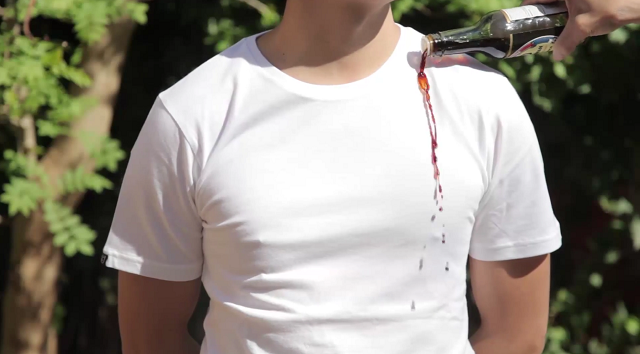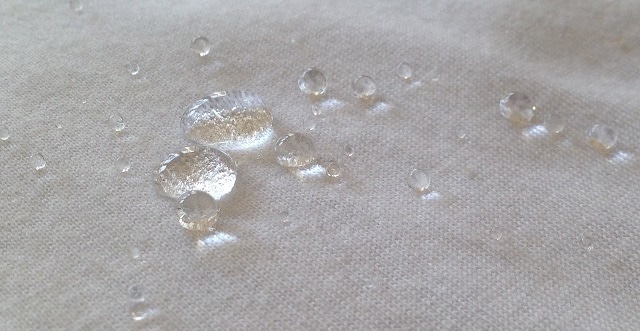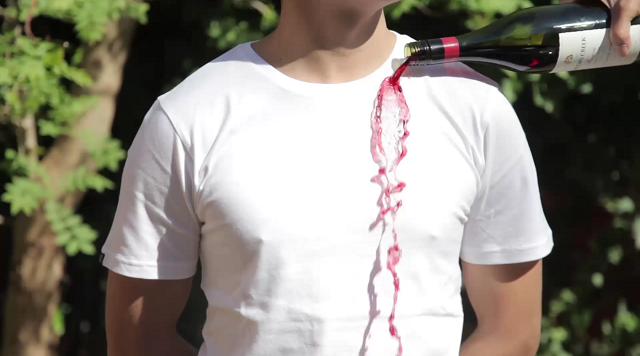
Soy Sauce being poured onto the Threadsmiths' Cavalier t-shirt. Image Credit: Threadsmiths
We have all been in the situation where we pull on our favorite white t-shirt only to spill red sauce on it moments later and be left with a horrible, permanent stain. This is all about to change thanks to Threadsmiths, a Melbourne-based fashion label, who have invented a hydrophobic t-shirt that, with the help of nanotechnology, is able to repel fluids and dirt.
The wettability of materials is characterized based on the contact angle between a droplet of water and the surface it has settled on. The lower this angle is, the more wettable, or hydrophilic, a material is said to be. On the other-hand, when water exhibits a high contact angle on a material surface it is said to be hydrophobic.
If the contact angle is greater than 150° a material is known as "superhydrophobic", sometimes referred to as the "Lotus Effect" due to the Lotus flower's characteristic of being able to strongly repel water. Plastics tend to have contact angles between 90-140°, and thus are considered to be hydrophobic.

Water beading up on the surface of the cotton material. Image Credit: Threadsmiths
The t-shirt manufactured by Threadsmiths is made from 100% cotton and is crafted with hydrophobic nanotechnology. It works by creating a microscopic barrier or "whisker"-like barrier between the t-shirt and the liquids it interacts with. There is then only a nano-sized surface area for liquids to adhere to, making it significantly more difficult for a liquid to integrate itself into the fabric. As a result, liquids simply "bead up" and roll of the surface.
David Mason from Threadsmiths spoke to AZoNano.com about the reasons behind the development of the shirt explaining that "we love white t-shirts, but we found them nearly impossible to keep clean so we decided to come up with a better solution. We knew that nanotechnology was the answer". The t-shirt is said to mimic the natural properties of the lotus leaf, which water flows off with ease.

Red wine being poured onto the Threadsmiths' Cavalier t-shirt. Image Credit: Threadsmiths
The nanotechnology is said to enhance resistance to common stains whilst not affecting the breathability of the material. "The nanotechnology application does not affect breathability," stated David Mason "the space between the threads in the weave is still intact". The fact that the space is intact allows for natural air flow through the material.
Threadsmiths say that the t-shirts are only the beginning, and they have plans to release a variation of different garments, "we are starting with the t-shirts and plan on coming out with a full range of polos, business shirts and pants. But we're open to suggestions to hear what people would like us to produce next".
The video below shows various different fluids being poured onto the t-shirt from Threadsmiths and then being cleaned off with water.
Threadsmiths Hydrophobic 100% Cotton T-Shirt
Threadsmiths Hydrophic 100% Cotton T-Shirt. Video source: Thread Smiths / YouTube
Other notable uses of the hydrophobic effect include nanocoatings to make waterproof mobile phones. P2i developed a hydrophobic nanocoating called "Dunkable™". This coating is able to protect electronics from accidental spillages and prolonged exposure to water.
As an increasing number of people take their smartphones into environments where they may be subjected to a host of different weather conditions, this new technology from P2i is a welcomed development.
The Dunkable™ coating is an electrical barrier. This means that it doesn't prevent water from getting into the device but it acts as a barrier to prevent it from damaging the electronics. It was tested under a variety of different fluids, including beer, wine and water, and all were successfully repelled by the innovative coating.
Nanocoatings have already made our smartphones even smarter, it now seems the era of smart-textiles is beckoning. Companies like Threadsmiths have produced stain-resistant t-shirts with other items of clothing on the horizon. Using nanocoatings to protect the surfaces of delicate materials is even being hypothesized.
Whether you are looking to make sure that your new suit remains clean on the day of an interview whatever life throws at you, or you simply want to be able to eat a jam donut without the fear of a big red stain on your white t-shirt, nanocoatings may be able to offer you the perfect solution.
Disclaimer: The views expressed here are those of the interviewee and do not necessarily represent the views of AZoM.com Limited (T/A) AZoNetwork, the owner and operator of this website. This disclaimer forms part of the Terms and Conditions of use of this website.